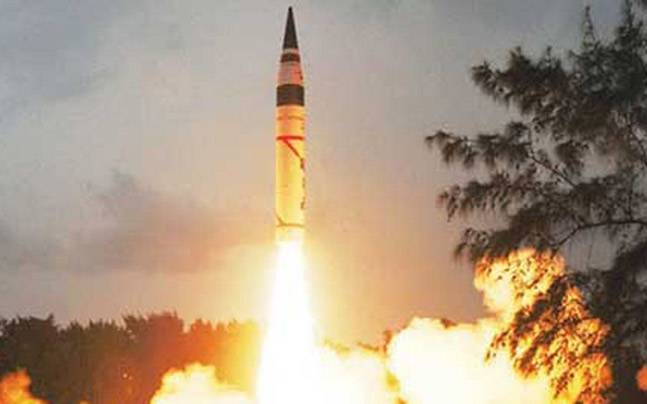India's most potent missile Agni 5 successfully tested
Mon 26 Dec 2016, 13:56:18

India today successfully test-fired its nuclear-capable, inter-continental ballistic missile Agni 5, that has a range of over 5,000 km covering whole of China, from Abdul Kalam island off Odisha coast.Defence sources said that the successful test-firing today will pave the way for user trial of the most potent Indian missile and its eventual induction into the special forces command (SFC).
The three-stage, solid propellant surface-to-surface missile was test-fired from a mobile launcher from launch complex-4 of the Integrated Test Range (ITR) at about 1105 hours, DRDO sources said.
About 17-metre long and weighing over 50 ton, the surface-to-surface missile majestically rose from the confines of its canister flawlessly and achieved all targets, sources in Defence Research and Development Organization (DRDO) said.
It is the fourth developmental and second canisterised trial of the missile.
While the first test was conducted on April 19, 2012, the second was on September 15, 2013 and the third on January 31, 2015 from the same base.Among the missiles of Agni series, the latest Agni-5 is the most advanced having some new technologies incorporated with it in terms of navigation and guidance, warhead and engine, the sources said.
Lot of new technologies developed indigenously were successfully tested in the trial. The very high
accuracy Ring Laser Gyro based Inertial Navigation System (RINS) and the most modern and accurate Micro Navigation System (MINS) had ensured the missile reached the target point within few meters of accuracy.
accuracy Ring Laser Gyro based Inertial Navigation System (RINS) and the most modern and accurate Micro Navigation System (MINS) had ensured the missile reached the target point within few meters of accuracy.
The high speed on board computer and fault tolerant software along with robust and reliable bus guided the Missile flawlessly, said a DRDO official.The missile is so programmed that after reaching peak of its trajectory, it turns towards earth to continue its journey towards the intended target with an increased speed due to the attraction of earth's gravitational pull and its path precisely directed by the advanced on-board computer and inertial navigation system.
The atmospheric air rubbing the skin of the missile during the re-entry phase raises the temperature to beyond 4000 degree Celsius.
However, the indigenously designed and developed carbon-carbon composite heat shield continues to burn sacrificially protecting the payload, maintaining the inside temperature below 50 degree Celsius.
Finally, commanded by the on-board computer with a support of highly accurate ring laser gyro based inertial navigation system, the most modern micro inertial navigation system (MINS), fully digital control system and advanced compact avionics, the missile hit the designated target accurately, meeting all mission objectives, they said.
No Comments For This Post, Be first to write a Comment.
Most viewed from Specials
Most viewed from World
AIMIM News
Latest Urdu News
Most Viewed
May 26, 2020
Do you think Canada-India relations will improve under New PM Mark Carney?
Latest Videos View All
Like Us
Home
About Us
Advertise With Us
All Polls
Epaper Archives
Privacy Policy
Contact Us
Download Etemaad App
© 2025 Etemaad Daily News, All Rights Reserved.






















.jpg)
.jpg)
.jpg)

















